- Bernard Preston homepage
- Beekeeping
- All-hive Mead
All-hive mead
An all-hive mead uses the cappings after harvesting the honey and some old combs with plenty of pollen too; nutrients for the yeast.
Brewing like most old-fashioned activities demands mindfulness, patience and time. In many ways it is closely allied to baking your own bread. Taking copious notes of the ingredients and details of how they were used is imperative. Temperature, pH and specific gravity are all important factors.
These are my first ramblings so you can follow the difficulties I had.
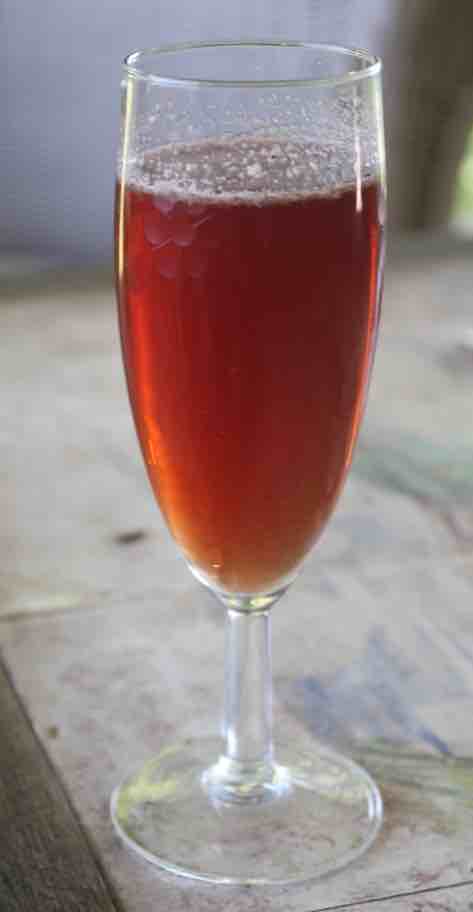
The huge advantage of this all-hive mead is that the nutrients for the yeast are supplied by the natural, lightly filtered honey and pollen without having to add various chemicals; the rich flavour is unique.
At the Royal Show in South Africa this last weekend, an all-hive mead was awarded the top bottle prize.
I follow the same principles when making my braggart, a honey beer but that has a much lower alcohol-content; around 6%.
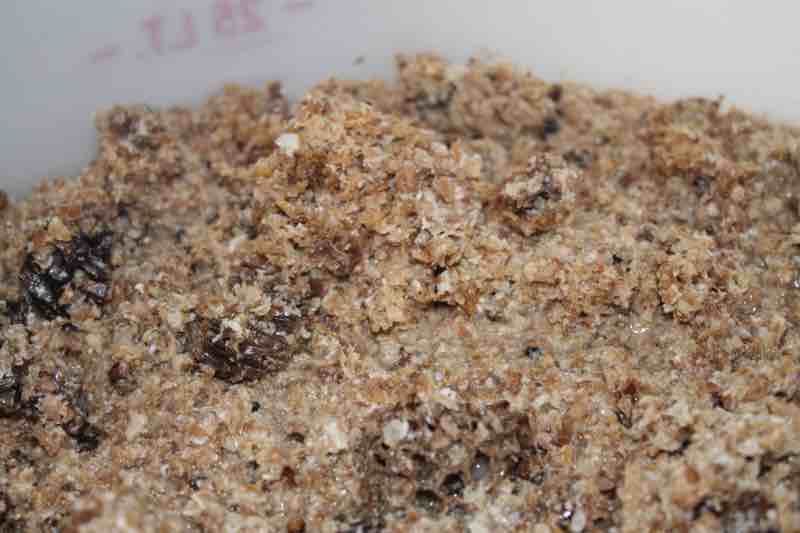
- A large carboy; this one holds 23 litres. You could also use a bucket.
- Several smaller demijohns that will hold at least two-thirds; in my case I settled for three five litre glass containers.
- An auto-syphon.
- Various bungs for a tight fit.
- A bubbler.
- A hydrometer.
- Thermometer.
- 10 ml pipette or wine thief.
- Two five-litre containers of cappings.
- Two old brood-combs.
- Extra honey.
- A small piece of comb with fresh pollen.
- Unchlorinated water to 2/3 fill the carboy.
- 1/2 tsp of white-yeast.
- Weigh the two five-litre containers of wax cappings. Multiply the figure in kilogrammes by 0.38 to get the approximate mass of honey; about 5kg. Filter to remove bee parts and other foreign matter and place them in a bag weighed down with smooth river pebbles in the carboy.
- Break up two old brood-combs into smallish pieces and add them to the carboy or bucket.
- Half-fill the carboy with rainwater heated in a kettle to 40oC, stir vigorously breaking up the pieces. Using the hydrometer, measure the specific gravity; it will be around 1.120.
- Add more liquid honey whilst continuing to stir; get the SG up to 1.150. Aerate the contents thoroughly for ten minutes[5].
- 12 hours later again check the SG is still around 1.15, note it; measure the temperature and add hot water, getting it back to 40oC.
- Do not more than 2/3 fill the carboy. If you do, this is likely to happen.
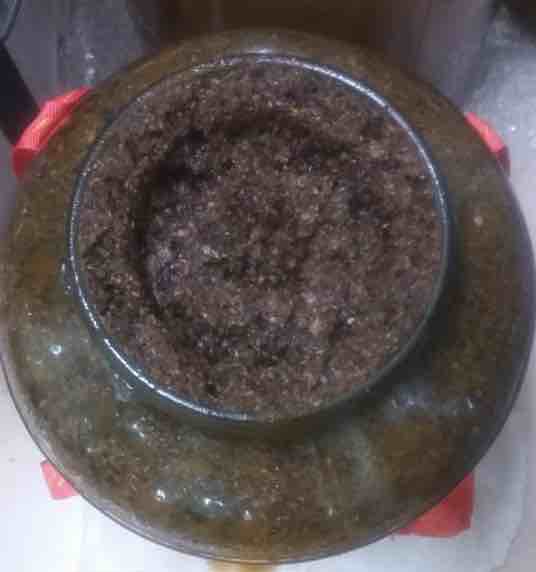
7. Add 1 tsp of yeast to 50ml of cold water in a mug; allow to hydrate.
8. Half an hour later, draw off roughly 25ml of the warm liquid and add it to the yeast mixed with cold water. Stir for a few minutes; and then pour it back into the carboy.
9. Fit the air-lock and allow the must to ferment for about 2 to 3 weeks depending on the ambient temperature; until bubbling ceases. Sometimes it may continue for much longer.
10. Test and note the SG and pH.
11. Using the auto-syphon rack the liquid off into the demijohns.
12. Rack the liquid off again after three-months leaving as much sediment behind as possible.
13. After another three months or so, if it has cleared then you can bottle; otherwise rack again.
Days 1 & 2: 13 December, 2021.
Dissolve 8kg of cappings in half a bucket of warm water at 40oC. Break two old broodcombs into the mixture.
Leave the mixture overnight for the wild fermentation to start. Stir vigorously with a long handled plastic spoon and get the temperature back to 40oC, filling the bucket or carboy to about two-thirds full.
I measured the specific gravity with a hydrometer; it may be difficult due to the thick nature of the wort but appeared to be about 1.050.
Used a 10g packet of Anchor bread yeast with a few tablespoons of warm water, waited half an hour for the fermentation to begin and then added a little of the wort; stirred vigorously and poured the mixture into bucket.
Sealed the bucket and fixed the air-lock, with a few millilitres of vodka, in place with a little Prestic. Now we wait for fermentation to start.
24 January, 2022
After six weeks the mead continues to bubble steadily every two minutes or so.
My auto-syphon has arrived and I will soon be testing the SG more accurately.
I'll be sharing difficulties and joys as I go along. For example I have realised there are contradictions concerning the specific gravity. Now that the wine-thief has arrived I will be able to get much more accurate readings.
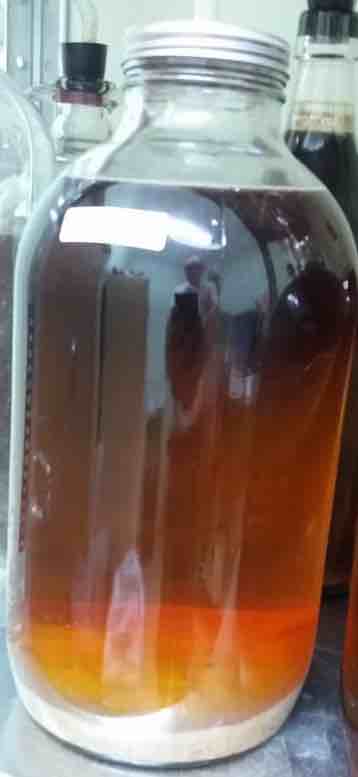
This is what Eddy Lear's all-hive mead looks like.
9th February, 2022
It's now 10 weeks since I started my all hive mead at the beginning of December. Fermentation has stopped and I used the auto-syphon to do the first rack. It looks like dirty, muddy water but has the kick of a mule!
SG = 1.060 and alcohol by volume 8%.
pH
So the range you want is 3.5 to 4.5.
Add 1.25ml of bicarb or tartaric acid per 0.5 adjustment on 5 litres in small tranches. After mixing in recheck pH. I usually do my measurements before fermentation but have also needed to do it at racking some times.
So I always add 5ml of lemon juice, if it's alkaline.
If your pH is 3 add 1.25ml Bicarb. If it is 5 then use 1.25 ml Tartaric acid; both in powder form. Stir without adding air into the mix; it may start an oxidisation process; you might end up with a vinegar.
Add 1.25ml of sodium bicarbonate per 0.5 adjustment on 5 litres.
To raise the pH from 2.0 to 3.5 one would need 3 x 1.25ml = 3.75; about half a teaspoon.
2nd May
Today I did the second rack and tested the pH. The colour on the test strip doesn't clearly match the given colours on the card.
My pH appeared to be about 1.5 so tentatively added 1/2 tsp bicarb powder when doing the second rack. It foamed quite badly and overflowed; next time I will add it more slowly.
5th June
Bottled the all-hive mead using the auto-syphen. It's very good but clearly needs to mature.
Racking
All yeast products have a mind of their own, just talk to bakers, but these are the guidelines for when to rack your mead.
- I usually do my first rack 6 - 12 weeks after making it.
- I rack it a second time after it is clear which could be 6 - 12 months later.
- If it was very clear when I started my 2nd rack, then after a week or two would move to bottling.
- If still a bit murky then another rack when it is clear, followed by bottling.
You can see from the photo of the first glass at the top of the page that I bottled before the all-hive mead had cleared.
There's a little dilemma to be considered. If you want your mead to act as a probiotic you need live yeast cells; it will not have cleared. Your mead will be a bit murky as above.
If you want a beautifully clear all-hive mead to impress your friends then you have to wait longer before bottling; it will in all probability also taste more mature.
Sweetness
In 23 litres use 8kg of honey for a sweet mead, 6.9kg for a semi-dry.
That is roughly 1tsp of honey less per glass of 125ml; about 6g.
Thoughts
The wax cappings took up too much room so I could not add enough water to the carboy.
In future I will mush the cappings up in a bucket of water using a potato-masher, strain and pour the gleanings into the carboy. The wax will go to the solar extractor.
If you feel tempted to brew your own, this is the basic mead equipment you will need.
An allied field is that your all hive mead will contribute to re-establishing the intestinal microbes in your gut; a subject of great complexity and importance. Equally complex is why even one glass of commercial alcohol per week increases the prevalence of malignant breast tumours; yet folk in four of the five Blue Zones drink natural local wines every day.
There is a growing realisation that whilst we are trying to eat good organic food, little thought has been given to healthy natural drink. The caffeine fad is behind us but sugary and artificially-sweetened colas remain firmly on the shopping list. And now the scary findings that are no longer just speculative; even small amounts of commercial alcohol provoke malignant tumours.
And so now there is growing interest in natural and organic wines, both those made from grapes and others from honey and berries.
Is it time to start keeping bees and making an all-hive mead?
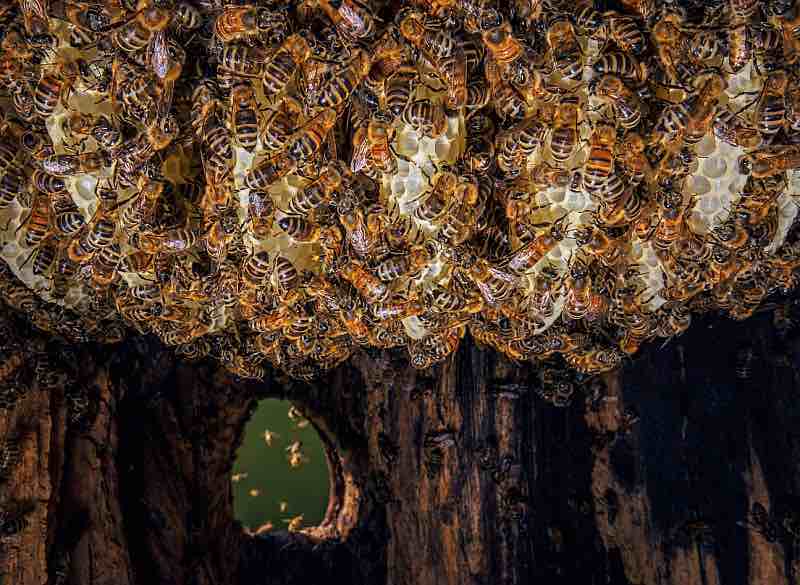
This photo is in appreciation of the remarkable work of photographer Ingo Arndt[1].
The standard drink
All are agreed that alcohol make a good servant but a very bad master.
However the research on how much alcohol is beneficial and when it starts to do damage is very contradictory.
Recent reports from the University of Saskatchewan state that even three standard drinks per week will increase the rate of malignant tumours, especially of the breast and colon.
The difficulty appears to stem from the fact that they did not take other lifestyle factors into account, nor considered natural, unpasteurised drinks such as all-hive mead; admittedly very few people would be consuming them.
The fact remains that people residing in the Blue Zones drink far more than these recommendations yet live into vigorous old age[4].
It is highly likely that the vast majority of drinkers also have a generally poor overall lifestyle.
A "standard" drink is defined as follow.
- 12 oz of beer, cooler or cider (5% alcohol); 12 oz x 30 = 360 ml.
- 5 oz
of wine (12% alcohol); 150 ml.
- 1.5 oz of spirits such as whiskey, vodka or
gin (40% alcohol); 45 ml.
The Paloma
The Paloma is fresh and delicious without being overly sweet. You mix a good mead with lime and grapefruit juice and serve it on the rocks garnished with a citrusy wedge.
Perhaps a little orange juice and turn it into a margarita. Forget the tequila for a truly memorable drink.
Yeast cells act as microbes
There are hundreds of friendly microbes inhabiting the happy gut. The bacteria consume dietary fibre and the yeast cells any remaining sugars not absorbed in the small intestine.
They both can metabolise uric acid secreted into the gut; and perhaps systemically in the blood and other tissues though this is not entirely proven yet. This has huge implications for those suffering from gout; the prevalence is soaring.
What is proven is that even small amounts of dietary cereal fibre significantly lowers the risk of gout; with your cob of corn for supper enjoy a glass of mead.
All-hive mead in moderation by acting as a probiotic certainly has huge plusses in dietary health.
When browsing use right click and "Open Link in New Tab" or you may get a bad gateway signal.
Newsletter
Our newsletter is entitled "create a cyan zone" at your home, preserving both yourself and Mother Earth for future generations; and the family too, of course. We promise not to spam you with daily emails promoting various products. You may get an occasional nudge to buy one of my books.
Here are the back issues.
- Lifestyle and ideal body weight
- What are ultra-processed foods?
- Investing in long-term health
- Diseases from plastic exposure
- Intensive lifestyle management for obesity has limited value
- A world largely devoid of Parkinson's Disease
- The impact of friendly bacteria in the tum on the prevention of cancer
- There's a hole in the bucket
- Everyone is talking about weight loss drugs
- Pull the sweet tooth
- If you suffer from heartburn plant a susu
- Refined maize meal and stunting
- Should agriculture and industry get priority for water and electricity?
- Nature is calling
- Mill your own flour
- Bake your own sourdough bread
- Microplastics from our water
- Alternative types of water storage
- Wear your clothes out
- Comfort foods
- Create a bee-friendly environment
- Go to bed slightly hungry
- Keep bees
- Blue zone folk are religious
- Reduce plastic waste
- Family is important
- What can go in compost?
- Grow broad beans for longevity
- Harvest and store sunshine
- Blue zone exercise
- Harvest and store your rainwater
- Create a cyan zone at your home
All hive mead
Now you know why all-hive mead can only be brewed by a beekeeper.
Did you find this page interesting? How about forwarding it to a friendly book or food junkie? Better still, a social media tick would help.
- Bernard Preston homepage
- Beekeeping
- All-hive Mead
Address:
56 Groenekloof Rd,
Hilton, KZN
South Africa
Website:
https://www.bernard-preston.com